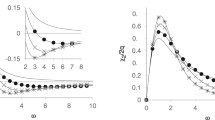Abstract
Using the memory conception developed in the framework of the Mori-Zwanzig formalism, the kinetic equations for relaxation functions that correspond to the previously suggested empirical functions (Cole-Davidson and Havriliak-Negami) are derived. The obtained kinetic equations contain differential operators of non-integer order and have clear physical meaning and interpretation. The derivation of the memory function corresponding to the Havriliak-Negami relaxation law in the frame of Mori-Zwanzig formalism is given. A physical interpretation of the power-law exponents involved in the Havriliak-Negami empirical expression is provided too.
Similar content being viewed by others
References
J.P. Boon, and S. Yip, Molecular Hydrodynamics. Dover, New York (1980), 435 p.
K.S. Cole, R.H. Cole, Dispersion and absorption in dielectrics, I. Alternating current characteristics. J. Chem. Phys. 9 (1941), 341–351.
A. Cuyt, V. Brevik Petersen, B. Verdonk, H. Waadeland, W.B. Jones, Handbook Continued Fractions for Special Functions. Springer Science+ Business Media B.V. (2008), 431 p.
D.W. Davidson, R.H. Cole, Dielectric relaxation in glycerol, propylene. Glycol, and n-propanol. J. Chem. Phys. 19 (1951), 1484–1490.
P. Debye, Polar Molecules. Dover, New York (1954).
A. Jurlewicz, K. Weron, M. Teuerle, Generalized Mittag-Leffler relaxation: Clustering-jump continuous-time random walk approach. Phys. Rev. E 78 (2008), # 011103.
S. Havriliak, S. Negami, A complex plane analysis of α-dispersions in some polymer systems. J. Polymer Sci.-Part C: Polymer Symposia 14, No 1 (1966), 99–117.
Y.P. Kalmykov, W.T. Coffey, D.S.F. Crothers and S.V. Titov, Microscopic models for dielectric relaxation in disordered systems. Phys. Rev. E 70 (2004), # 041103-1-11.
A.A. Kilbas, M. Saigo, and R.K. Saxena, Generalized Mittag-Leffler function and generalized fractional calculus operators. Integr. Transf. Spec. Funct. 15 (2004), 31–49.
A.A. Khamzin, R.R. Nigmatullin, I.I. Popov, Microscopic model of a non-Debye dielectric relaxation: The Cole-Cole law and its generalization. Theoretical and Math. Physics 173, No 2 (2012), 1604–1619.
A.A. Khamzin, R.R. Nigmatullin, I.I. Popov, Log-periodic corrections to the Cole-Cole expression in dielectric relaxation. Physica A 392 (2013), 136–148
A.A. Khamzin, R.R. Nigmatullin, I.I. Popov, B.A. Murzaliev, Microscopic model of dielectric α-relaxation in disordered media. Fract. Calc. Appl. Anal. 16, No 1 (2013), 158–170; DOI: 10.2478/s13540-013-0011-1; http://link.springer.com/article/10.2478/s13540-013-0011-1.
H. Mori, A continued-fraction representation of the time correlation function. Prog. Theor. Phys. 30 (1965), 399–416.
R.R. Nigmatullin, D. Baleanu, The derivation of the generalized functional equations describing self-similar processes. Fract. Calc. Appl. Anal. 15, No 4 (2012), 718–740; DOI: 10.2478/s13540-012-0049-5; http://link.springer.com/article/10.2478/s13540-012-0049-5.
R.R. Nigmatullin, Ya.A. Ryabov, Cole-Davidson dielectric relaxation as a self-similar relaxation process. Phys. Solid State 39 (1997), 87–90.
V.V. Novikov, V.P. Privalko, Temporal fractal model for the anomalous dielectric relaxation of inhomogeneous media with chaotic structure. Phys. Rev. E 64 (2001), # 031504-1-11.
T.R. Prabhakar, A singular integral equation with a generalized Mittag Leffler function in the kernel. Yokohama Math. J. 19 (1971), 7–15.
S.G. Samko, A.A. Kilbas and O.I. Marichev, Fractional Integrals and Derivatives. Theory and Applications. Gordon and Breach, Amsterdam (1993).
V.V. Uchaikin, R. Sibatov, Fractional Kinetics in Solids. Anomalous Charge Transport in Semiconductors, Dielectrics and Nanosystems. World Scientific Publ. Ltd, Singapore (2013).
K. Weron, A. Jurlewicz, M. Magdziarz, Havriliak-Negami response in the framework of the continuous-time random walk. Acta Phys. Pol B. 36 (2005), 1855–1868.
G. Williams, Use of the dipole correlation function in dielectric relaxation. J. Chem. Rev. 72 (1972), 55–69.
R. Zwanzig, Lectures in Theoretical Physics. Interscience, New York (1961), 135 p.
Author information
Authors and Affiliations
Corresponding author
About this article
Cite this article
Khamzin, A.A., Nigmatullin, R.R. & Popov, I.I. Justification of the empirical laws of the anomalous dielectric relaxation in the framework of the memory function formalism. fcaa 17, 247–258 (2014). https://doi.org/10.2478/s13540-014-0165-5
Received:
Published:
Issue Date:
DOI: https://doi.org/10.2478/s13540-014-0165-5



